In the spring and summer months, when the warblers arrive, it’s quite common to spot yellow birds in Nova Scotia. However, during the winter season, the American Goldfinch is the only yellow bird that is frequently seen here.
To assist you in identifying the yellow birds you encounter in Nova Scotia, this comprehensive guide provides you with pictures, identification details, song recordings, and information about their migration patterns.
The majority of yellow birds found in Nova Scotia belong to the warbler, finch, or oriole families, and sometimes the female birds look strikingly different from their male counterparts.
With the abundance of information provided in this guide, identifying yellow birds will become a much simpler task. The birds have been listed according to their frequency of sightings in Nova Scotia during the spring and summer months (May and June) based on ebird checklists.
Yellow birds that can be found in Nova Scotia throughout the year include the American Goldfinch, Evening Grosbeak, and Eastern Meadowlark. During the summer season, you can spot Yellow-rumped Warblers, Common Yellowthroats, Yellow Warblers, Cedar Waxwings, American Redstarts, Black-throated Green Warblers, Magnolia Warblers, Palm Warblers, Nashville Warblers, and Canada Warblers. And during migration, keep an eye out for Baltimore Orioles, Wilson’s Warblers, Cape May Warblers, and Orange-crowned Warblers.
So, read on to identify the yellow birds you’ve spotted in Nova Scotia.
17 Yellow Birds in Nova Scotia:
1. American Goldfinch
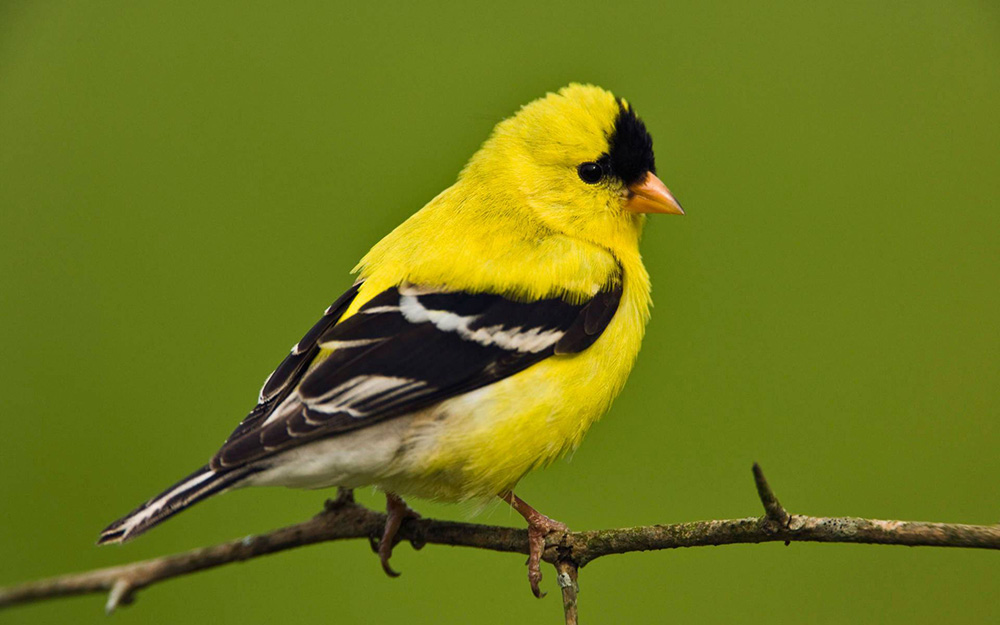
In Nova Scotia, American Goldfinches are present all year round, but their numbers increase during the breeding season from April to September. They are reported in 49% of summer checklists and 31% of winter checklists submitted by birdwatchers in the province.
American Goldfinches are quite popular. The males exhibit bright yellow and black plumage during spring, while the females and males in winter have duller brown coloring.
Spinus tristis
Length: 4.3-5.1 inches (11-13 cm)
Weight: 0.4-0.7 ounces (11-20 g)
Wingspan: 7.5-8.7 inches (19-22 cm)
American Goldfinches can be found across most of North America and are usually residents throughout the year. However, those that breed in Canada and the Midwest migrate to the southern United States for winter.
You can find American Goldfinches foraging for food such as sunflower seeds, thistles, and aster plants in weedy fields, overgrown areas, suburbs, parks, and even backyards.
Song of the American Goldfinch:
American Goldfinches build their nests in saplings or shrubs using grass, bark strips, and feathers. The female lays four to six eggs, which take approximately ten to twelve days to hatch. While the male feeds the female, she incubates the eggs.
To attract American Goldfinches to your backyard, consider planting thistles and milkweed. They are known to visit most types of bird feeders and have a preference for sunflower and nyjer seeds.
Fun Fact: Brown-headed Cowbirds are notorious for laying their eggs in American Goldfinch nests. However, since the seed-based diet provided by the parents is unsuitable for the cowbird chicks, they usually do not survive.
2. Yellow-rumped Warbler

Yellow-rumped Warblers can be observed during the breeding season in Nova Scotia, but their numbers are higher during the migration periods from May to June and September to October. They are recorded in 26% of summer checklists and up to 41% of checklists during migrations.
Yellow-rumped Warblers have gray plumage with flashes of yellow on their faces, sides, and rumps. Their wings are white.
Females may have a slight brownish tinge, and during winter, these birds exhibit paler brown colors with bright yellow rumps and sides. As spring arrives, their plumage transitions back to a combination of yellow and gray.
Setophaga coronata
Length: 4.7-5.5 inches (12-14 cm)
Weight: 0.4-0.5 ounces (12-13 g)
Wingspan: 7.5-9.1 inches (19-23 cm)
Yellow-rumped Warblers primarily breed in Canada, parts of the Rockies, and the Appalachian Mountains.
During migration, they can be spotted in the Midwest before heading to their winter grounds in the southern and southwestern United States, the Pacific Coast, and even Mexico and Central America.
You can find Yellow-rumped Warblers in coniferous forests, especially during the breeding season. In winter, they tend to frequent open areas with fruiting shrubs. Their diet consists mainly of insects during summer and migration, while in winter, they rely more on fruits like bayberry and wax myrtle.
Song of the Yellow-rumped Warbler:
Nests of Yellow-rumped Warblers are constructed by females in conifer trees using twigs, pine needles, and grass. They line the nests with soft grass, moss, and hair. A clutch usually consists of up to six eggs, which take around two weeks to hatch. The young birds will leave the nest after another two weeks.
To attract Yellow-rumped Warblers to your backyard, provide them with sunflower seeds, suet, raisins, and peanut butter.
Fun Fact: During winter, Yellow-rumped Warblers can form flocks of thousands and display aggression towards other species that venture too close.
3. Common Yellowthroat
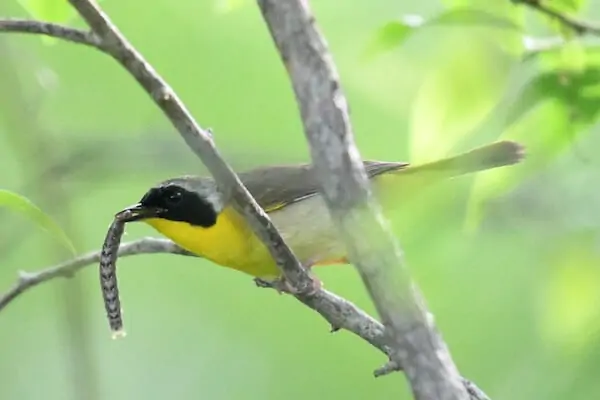
Common Yellowthroats are present in Nova Scotia during the breeding season and can be observed in 27% of summer checklists. They arrive in April and begin their migration in October.
Common Yellowthroats are small songbirds with brownish backs and vibrant yellow undersides. The males have black masks across their faces. The intensity of their yellow coloration can vary depending on their geographic location, and some individuals may exhibit more olive tones.
Geothlypis trichas
Length: 4.3-5.1 inches (11-13 cm)
Weight: 0.3-0.3 ounces (9-10 g)
Wingspan: 5.9-7.5 inches (15-19 cm)
Common Yellowthroats breed across most of North America, excluding Alaska and northern Canada. Some individuals remain along the Gulf Coast and Pacific Southwest throughout the year. During the winter, they migrate south.
You can find Common Yellowthroats in marshy or wetland areas and brushy fields, particularly amidst thick, tangled vegetation.
Song of the Common Yellowthroat:
Nests of Common Yellowthroats are built by females near the ground in marshy areas, supported by reeds. These nests are composed of grass and sedges woven together, with a platform made of leaves and grass. They lay up to six eggs, which take around twelve days to hatch. The young birds will leave the nest within the same timeframe.
To attract Common Yellowthroats to larger backyards, create dense vegetation with native plants that can attract insects.
Fun Fact: The black mask of the male Common Yellowthroat serves as a signal to courting males, triggering aggressive responses towards simulated birds with masks. Interestingly, they do not display such aggression when the simulated bird lacks a mask.
4. Yellow Warbler
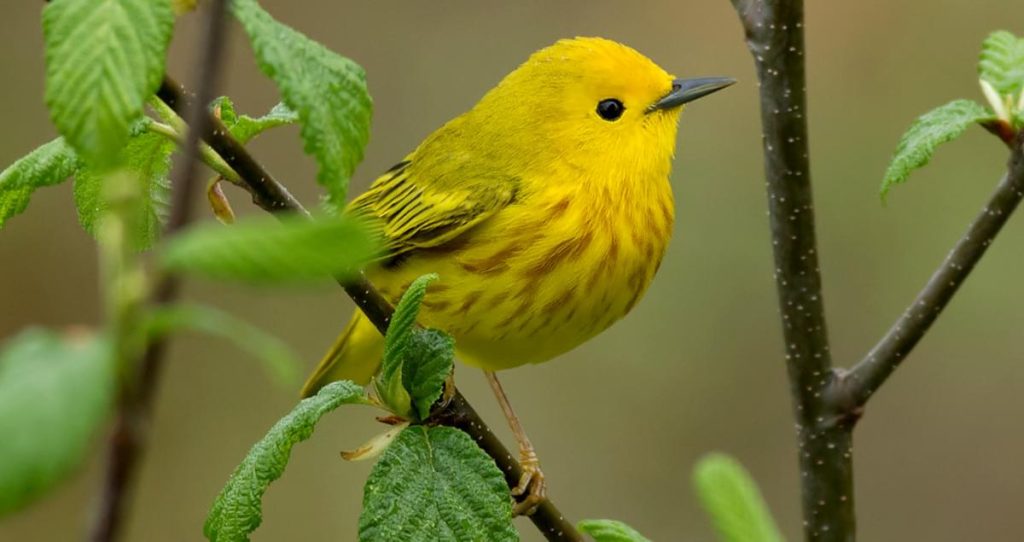
Yellow Warblers are the second most frequently sighted yellow birds during the breeding season in Nova Scotia, appearing in 27% of summer checklists. They are primarily seen from April to September, although a few individuals may remain until December.
Yellow Warblers are small, brightly colored birds with yellow plumage and a yellow-green back. Male Yellow Warblers feature chestnut streaks on their breasts, while females and juveniles exhibit less vibrant coloration.
Setophaga petechia
Length: 4.7-5.1 inches (12-13 cm)
Weight: 0.3-0.4 ounces (9-11 g)
Wingspan: 6.3-7.9 inches (16-20 cm)
Yellow Warblers undertake long-distance migrations to breed in Canada and the United States, excluding southeastern states. During migration, they can be seen in southeastern US states.
Yellow Warblers are often found along streams, in wetlands, and within thickets along field edges. They primarily feed on insects, including caterpillars, midges, beetles, bugs, and wasps.
Song of the Yellow Warbler:
Nests of Yellow Warblers are built in small trees or shrubs using bark, grass, and plant materials woven together. Spider webs help secure the nest, which is then lined with softer materials such as hair, feathers, and plant down.
The female lays up to seven eggs, which take approximately twelve days to hatch. The young birds will leave the nest after another ten days.
To attract Yellow Warblers to your backyard, provide them with suet, oranges, peanut butter, and plants that bear berries. Additionally, cultivate native plants that attract insects without the use of pesticides and maintain a natural environment. Consider installing birdbaths with fountains near secluded planting areas to provide protection.
Fun Fact: Yellow Warblers often encounter the brood parasitism of Brown-headed Cowbirds. When cowbird eggs are detected, Yellow Warblers abandon the nest and build a new one on top of the old nest, repeating the process multiple times if necessary.
5. Cedar Waxwing
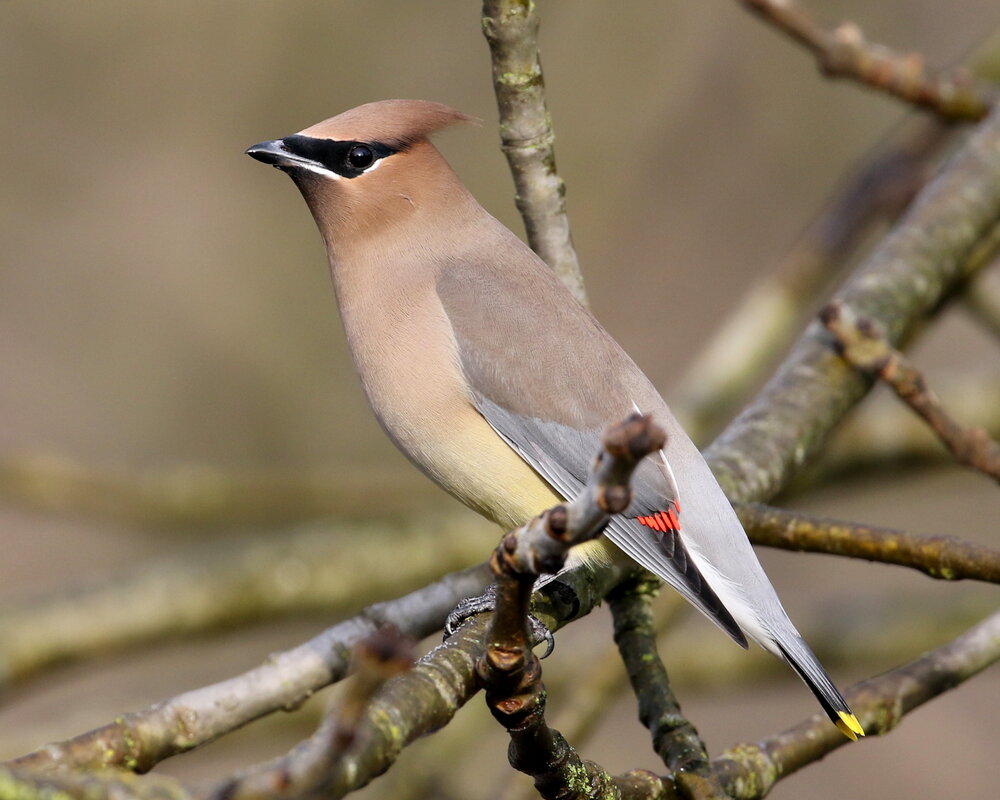
Cedar Waxwings are commonly seen in Nova Scotia during the breeding season, particularly from June to October. While they occur in 14% of summer checklists, their presence in winter is only reported in 1% of checklists.
Cedar Waxwings are elegant and sociable birds with pale brown heads, chests, and crests. The brown gradually transitions to gray on their backs and wings, with a pale yellow belly. They possess bright yellow tips on their tails and a narrow black mask over their eyes, along with striking red wingtips.
Bombycilla cedrorum
Length: 5.5-6.7 inches (14-17 cm)
Weight: 1.1 ounces (32 g)
Wingspan: 8.7-11.8 inches (22-30 cm)
Cedar Waxwings breed in Canada before migrating to the southern United States, Mexico, and Central America for winter. However, they can be found year-round in the northern states of the United States.
Cedar Waxwings are commonly found in berry bushes, woodlands, grasslands, towns, and along streams. Their diet primarily consists of fruits, but they also consume insects during the summer season.
Call of the Cedar Waxwing:
Nests of Cedar Waxwings are built in trees using twigs, grass, hair, and plant materials. They line the nest with pine needles and soft grass. The female lays up to six eggs, which take around twelve days to hatch. The young birds will leave the nest after approximately sixteen days.
To attract Cedar Waxwings
to your backyard, plant native trees and shrubs that produce small fruits such as serviceberry, dogwood, juniper, winterberry, and hawthorn. Additionally, try offering fruit on platform feeders.
Fun Fact: Cedar Waxwings engage in a unique behavior of giving gifts during courtship, passing items between potential mates.
6. American Redstart Female

American Redstarts spend their summers in Nova Scotia and appear in 18% of checklists during this period. They are usually observed from May to October, with a few individuals remaining until December.
Male American Redstarts display predominantly black plumage with vibrant orange patches and a white belly. Females, on the other hand, possess olive-gray coloration instead of black and feature numerous yellow patches.
Setophaga ruticilla
Length: 4.3-5.1 inches (11-13 cm)
Weight: 0.2-0.3 ounces (6-9 g)
Wingspan: 6.3-7.5 inches (16-19 cm)
American Redstarts breed in eastern United States and Canada, extending to northwestern US states. During migration, they may also be spotted in central and western US states.
American Redstarts can be found in deciduous woodlands, where they feed on insects. They are also known to frequent backyards and thickets where they consume berries like serviceberry and magnolia.
Song of the American Redstart:
Nests of American Redstarts are constructed near the trunk of trees or large shrubs using bark, grass, and other plant materials. The female lays up to five eggs, which take just under two weeks to hatch. The young birds will leave the nest after one to two weeks.
To attract American Redstarts to your backyard, provide them with berry plants such as magnolia and serviceberry.
Fun Fact: When feeding their young, American Redstart parents selectively feed certain chicks, demonstrating a unique feeding strategy.
7. Black-throated Green Warbler
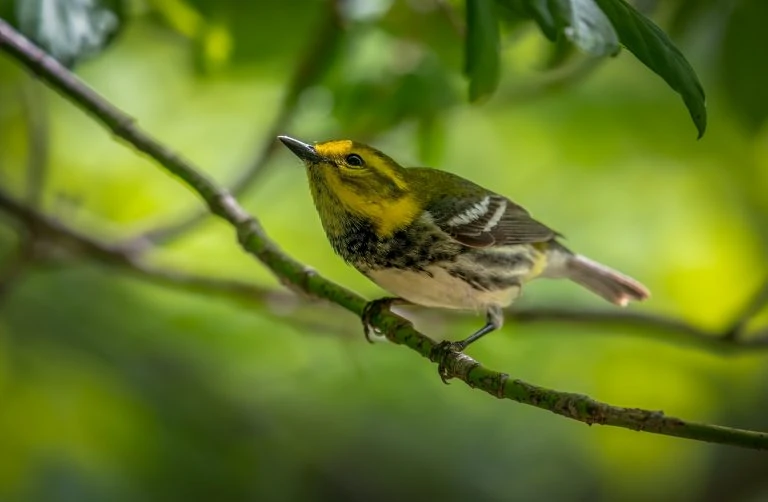
Black-throated Green Warblers are summer residents in Nova Scotia and are observed in 16% of checklists during this time. They are primarily seen from mid-April to mid-November.
Black-throated Green Warblers are small yellow songbirds with yellow faces, heads, and olive-yellow backs. They have black streaks on their sides and wings, while their underparts are whitish. Male individuals feature large black patches on their throats, whereas the black throat markings are smaller in females and juveniles.
Setophaga virens
Length: 4.3-4.7 inches (11-12 cm)
Weight: 0.3-0.4 ounces (7-11 g)
Wingspan: 6.7-7.9 inches (17-20 cm)
Black-throated Green Warblers can be observed during their extensive migration across the eastern United States toward their breeding grounds in northeastern US states and Canada. During winter, they can be found in Mexico, northern South America, and the Caribbean.
These warblers can be spotted high up in forests, particularly in tree canopies, where they feed on insects. Their distinctive black throat helps differentiate them from other small yellow birds.
Song of the Black-throated Green Warbler:
Nests of Black-throated Green Warblers are typically built in small trees close to the trunk. They are constructed using twigs, bark, and grass, woven together with spider webs. The nests are lined with animal hair, moss, and feathers. A typical clutch consists of around four eggs, which take twelve days to hatch. The young birds leave the nest after approximately ten more days.
To attract Black-throated Green Warblers to your backyard, maintain mature trees that can provide suitable nesting habitats.
Fun Fact: Male Black-throated Green Warblers can sing more than 400 times in an hour and perform a “gloating” flight after chasing away rivals.
8. Magnolia Warbler
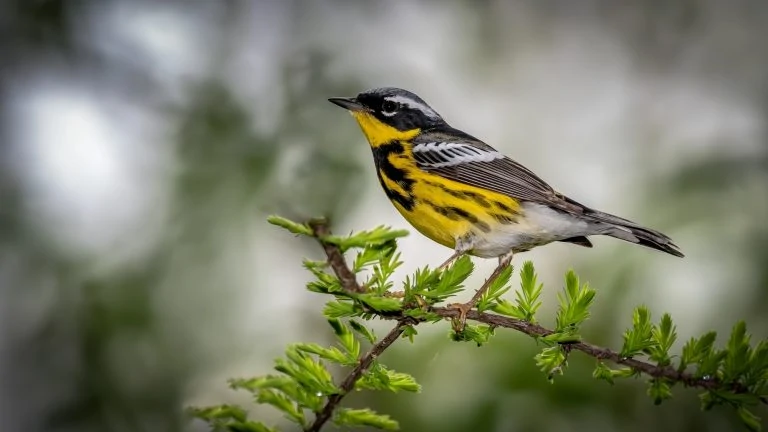
Magnolia Warblers are commonly sighted in Nova Scotia from May to October, appearing in 14% of summer checklists.
Male Magnolia Warblers exhibit black backs and yellow underparts. They have black streaking that forms a “necklace” pattern on their necks and bellies. In contrast, females possess grayer backs and lack the distinctive streaking on the belly.
Setophaga magnolia
Length: 4.3-5.1 inches (11-13 cm)
Weight: 0.2-0.5 ounces (6-15 g)
Wingspan: 6.3-7.9 inches (16-20 cm)
Magnolia Warblers breed across Canada and northeastern US states. During migration, they can be observed in the eastern United States. In winter, they migrate to Central America and the Caribbean.
These warblers can be found perched on low branches in forests or parks, making them more visible during migration periods. They primarily feed on insects and spiders.
Song of the Magnolia Warbler:
Nests of Magnolia Warblers are loosely constructed using grass, weeds, and placed close to the trunk of conifer trees. They lay around four eggs, which take approximately twelve days to hatch. The young birds will leave the nest within nine days.
To attract Magnolia Warblers to your backyard, create a suitable habitat with native shrubs and trees that can provide resting spots during migration.
Fun Fact: Male Magnolia Warblers use the white spots on their tails to attract females and ward off rivals.
9. Palm Warbler
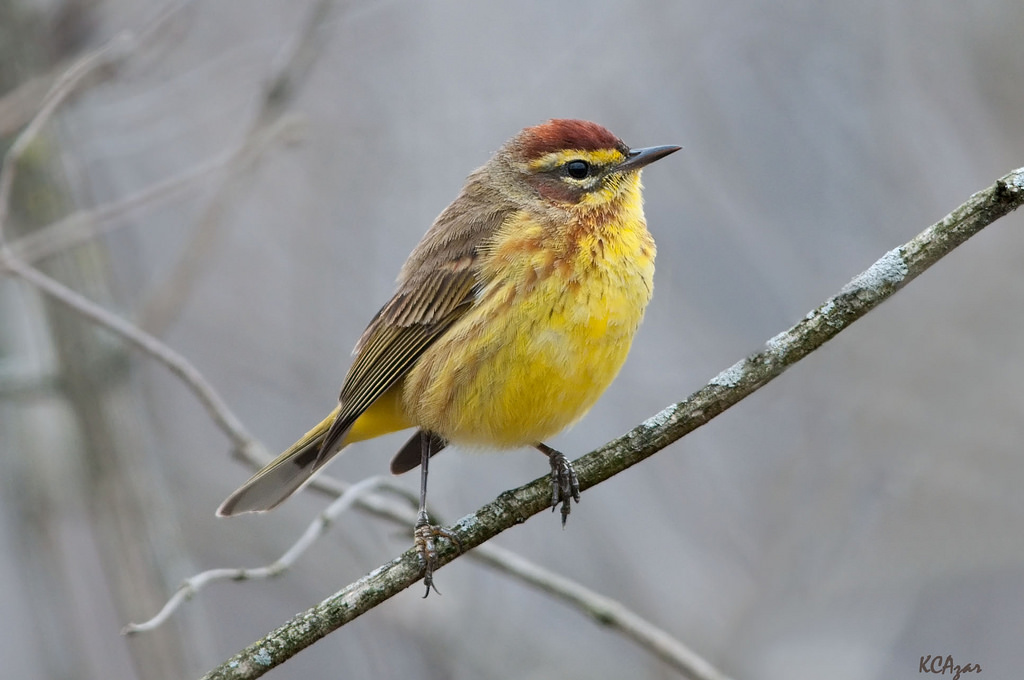
Palm Warblers are seen in Nova Scotia during the summer, but they are more common during spring and fall migration. They appear in 6% of summer checklists and up to 13% of checklists during migration.
Palm Warblers have a rusty red patch on the top of their heads and exhibit a browny-olive coloration on the rest of their bodies. While they breed in Canada, they can also be found in eastern US states during migration. Additionally, some individuals winter in Florida and along the southeastern coast.
Setophaga palmarum
Length: 4.7-5.5 inches (12-14 cm)
Weight: 0.3-0.5 ounces (7-13 g)
Wingspan: 7.9-8.3 inches (20-21 cm)
Palm Warblers primarily breed in Canada and migrate through eastern US states. They have a significant presence during the spring and fall migration. Some individuals choose to spend their winters in Florida and along the southeastern coast.
These warblers can be spotted in weedy fields, forest edges, and scrubby areas during migration. They often forage on the ground, alongside other bird species like sparrows, juncos, and yellow-rumped warblers, searching for insects.
Song of the Palm Warbler:
Nests of Palm Warblers are found in bogs and boreal forests, built on the ground using grass, sedge, and ferns woven into a cup shape. The nests are lined with soft grass, feathers, and animal hair. Palm Warblers lay around five eggs.
To attract Palm Warblers to your backyard, plant native plants that attract insects and consider adding bayberry or hawthorn shrubs for their berries.
Fun Fact: Unlike most warblers, Palm Warblers often walk on the ground, bobbing their tails as they search for insects.
10. Evening Grosbeak
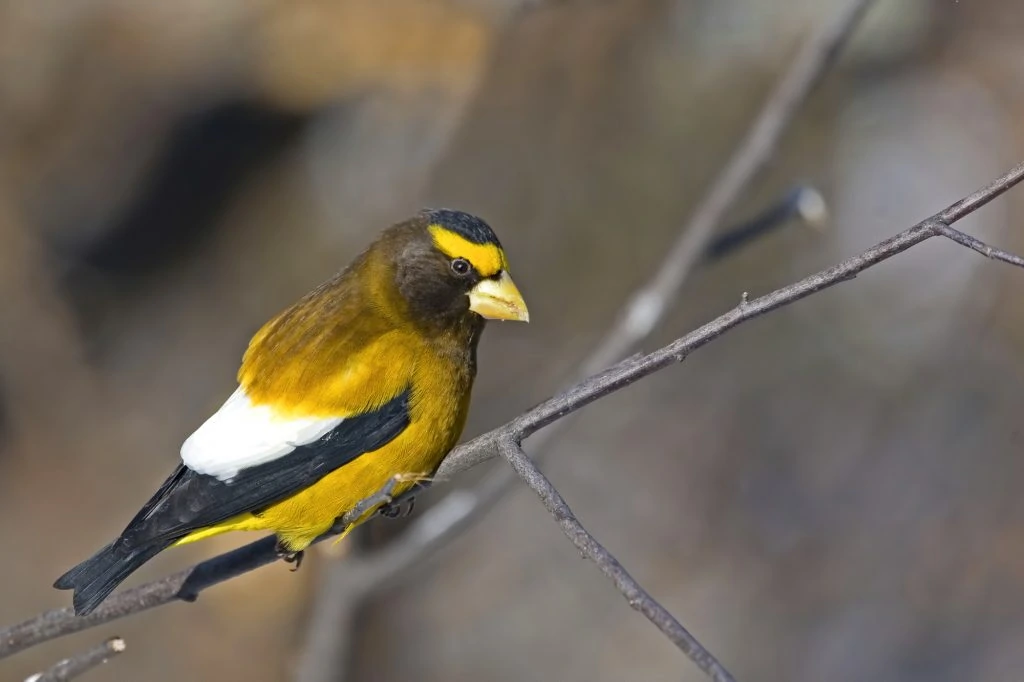
Male Evening Grosbeak, Coccothraustes vespertinus, in a tree Evening Grosbeaks are vulnerable species in Nova Scotia, but they can be observed throughout the year. They appear in 3% of both summer and winter checklists.
Evening Grosbeaks are robust birds with large bills and a striking yellow and black pattern. Adult males feature a bright yellow stripe across their eyes, which gives them a fierce appearance. Their heads are black, and their necks are gray, while their chest and belly exhibit a vibrant yellow color. They also display a white patch on their wings.
Females and juvenile males have greenish bills, gray bodies, black and white wings, and a yellow tinge on their necks.
Hesperiphona vespertina
Length: 6.3 to 8.7 inches (16 to 22 cm)
Weight: 1.37 to 3.04 ounces (38.7 to 86.1 g)
Wingspan: 12 to 14 inches (30 to 36 cm)
Evening Grosbeaks remain in southern Canada throughout the year, extending down the west coast to northern California. However, when cone crops are scarce, they migrate to various regions in the United States.
These grosbeaks can be found in forests and mountainous areas. During winter, they are often attracted to bird feeders in backyards, as they provide a convenient food source.
Evening Grosbeaks naturally feed on flower buds during spring, insect larvae from treetops in summer, and they flock to backyard feeders or consume seeds, berries, and small fruit in winter.
Call of the Evening Grosbeak:
Nests of Evening Grosbeaks are typically found up to 100 feet above ground in pine trees. They are loosely constructed using twigs, rootlets, grass, moss, and pine needles. A female Evening Grosbeak lays up to five eggs, and she incubates them for approximately two weeks until they hatch.
To attract Evening Grosbeaks to your backyard during winter, provide them with sunflower seeds, berries, and maple buds.
Fun Fact: Evening Grosbeaks possess powerful bills capable of crushing seeds that are too hard for smaller birds to open. Consequently, these birds often linger to feed on what remains after others have finished.
11. Nashville Warbler

Nova Scotia catches a glimpse of the Nashville Warbler during the breeding season, with 3% of summer checklists featuring this delightful species. Their arrival commences in May, and their migration begins in November.
Sporting a yellow underside with a touch of white on the lower belly, Nashville Warblers boast a greenish-yellow back and a gray head adorned with a white eyering. While females and juveniles exhibit slightly muted hues compared to their male counterparts, they remain a captivating sight.
Scientific name: Leiothlypis ruficapilla
Length: 4.3-5.1 inches (11-13 cm)
Weight: 0.2-0.5 ounces (6.7-13.9 g)
Wingspan: 6.7-7.9 inches (17-20 cm)
Nashville Warblers find their breeding grounds in the northeastern United States and Canada, with a smaller population also residing in northwestern US states and stretching into British Columbia. During migration, they traverse various regions across the eastern half of the United States. When winter arrives, they predominantly spend their time in Mexico.
These warblers can be spotted in scrubby habitats and low deciduous forests, diligently hunting for insects.
Behold the song of the Nashville Warbler:
Credit: XC512262, Peter Ward and Ken Hall. Accessible at www.xeno-canto.org/512262.
Nashville Warbler nests nestle inconspicuously in shrubs close to the ground. Constructed with a blend of bark, grass, moss, and woven into a cup shape, the nest provides a cozy haven lined with soft material. A clutch typically consists of four eggs, which hatch in approximately twelve days, followed by another ten days before the young take flight.
To entice Nashville Warblers to visit your backyard during the winter season in southern US states, consider providing suet as a welcoming treat.
Fun Fact: During their first year, Nashville Warblers migrate along the Atlantic Coast but venture inland thereafter.
12. Baltimore Oriole Female
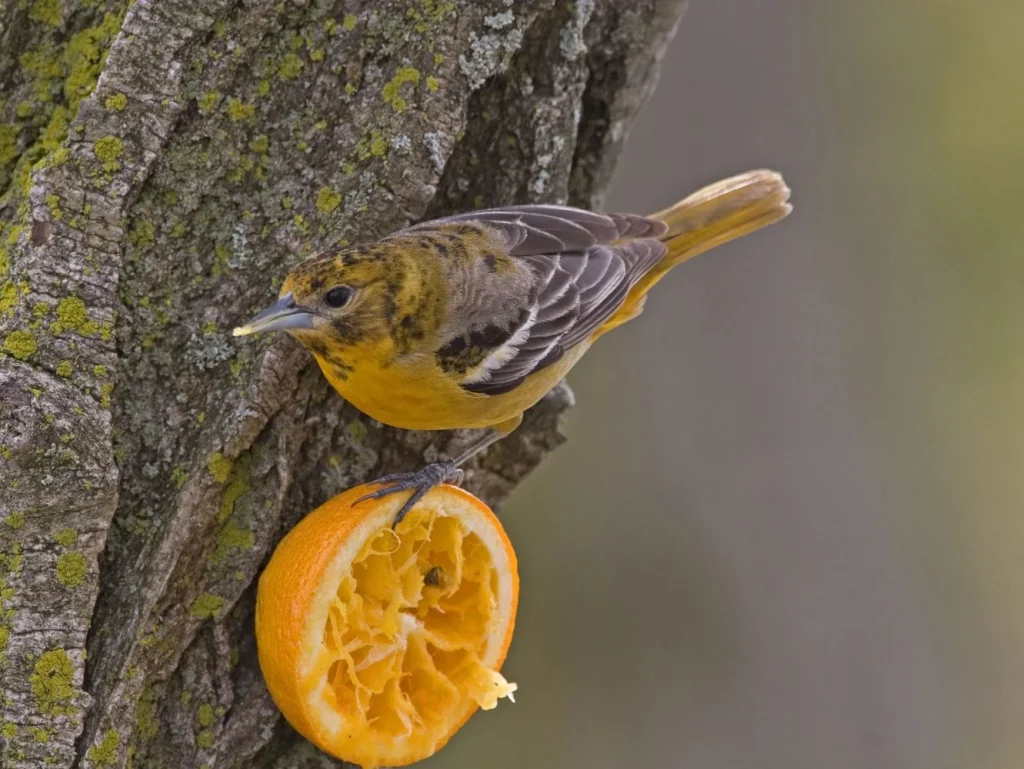
Nova Scotia is graced with the presence of Baltimore Orioles during spring and fall migration, and some even choose to linger through the winter.
As heralds of spring in the eastern region of North America, Baltimore Orioles display a vibrant color palette. Adult males boast bright orange and black plumage, adorned with white wing bars accentuating their black wings.
Females, on the other hand, showcase yellowish undersides and heads, with grayish-brown wings and brownish-yellow backs. These slender birds are approximately the size of a Robin and belong to the blackbird family.
Scientific name: Icterus galbula
Length: 6.7-7.5 inches (17-19 cm)
Weight: 1.1-1.4 ounces (30-40 g)
Wingspan: 9.1-11.8 inches (23-30 cm)
Baltimore Orioles breed in the Eastern and Central States, including central-southern Canadian provinces and areas along the southern border of the United States. Come winter, they embark on a journey to Florida, Central America, and the Caribbean, departing as early as July.
You can encounter Baltimore Orioles in open woodlands, riverbanks, forest edges, and they occasionally grace parks and backyards with their presence. Their diet primarily consists of insects such as beetles, crickets, grasshoppers, spiders, and snails. Furthermore, they play a valuable role in pest control while also relishing various fruits. However, they may cause damage to crops such as raspberries, mulberries, cherries, bananas, and oranges.
Listen to the melodic sounds of the Baltimore Oriole:
Credit: XC103509, Andrew Spencer. Accessible at www.xeno-canto.org/103509.
To attract Baltimore Orioles to your backyard, entice them with halves of oranges on a platform feeder or suspend them from trees. Additionally, oriole feeders filled with sugar water can be appealing. Planting fruiting plants and nectar-rich varieties like raspberries, crab apples, and trumpet vines may also help attract these colorful visitors.
Fun Fact: Baltimore Orioles are skilled weavers, crafting incredible hanging nests resembling bags from various fibers.
13. Canada Warbler
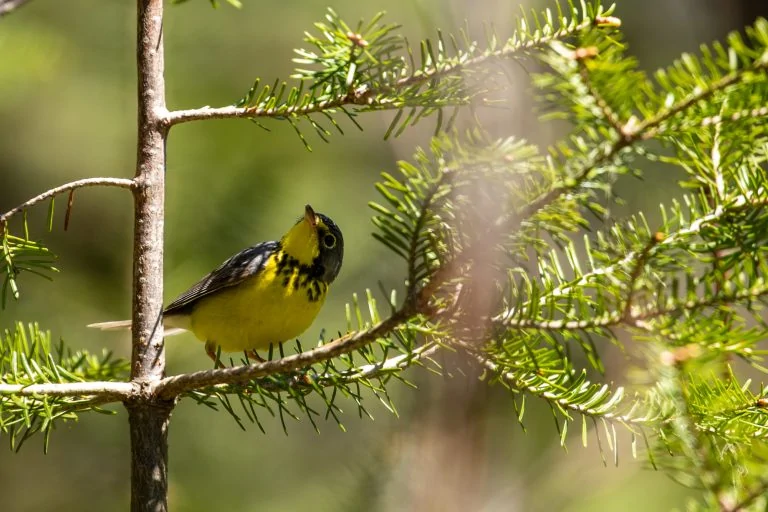
From May until October, Canada Warblers make appearances in Nova Scotia, accounting for 1% of summer checklists.
Resembling the Magnolia Warbler in appearance and range, Canada Warblers possess a grayish-black back and a distinct “necklace” in males that extends over the chest rather than the belly. Their chests, bellies, and throats exhibit a vibrant shade of yellow.
Females and immatures share a similar appearance but with paler tones on the back and a less prominent “necklace.”
Scientific name: Cardellina canadensis
Length: 4.7-5.9 inches (12-15 cm)
Weight: 0.3-0.5 ounces (9-13 g)
Wingspan: 6.7-8.7 inches (17-22 cm)
Canada Warblers breed in Canada and northeastern US states, although they can also be observed during migration across the eastern half of the United States. During winter, they venture to western South America.
Rhododendron-filled conifer forests or aspen and poplar forests serve as the favored habitats for Canada Warblers as they forage diligently for insects and spiders. However, their declining numbers make them a challenging find.
Enjoy the melodic song of the Canada Warbler:
Credit: XC512275, Peter Ward and Ken Hall. Accessible at www.xeno-canto.org/512275.
Nests of the Canada Warbler are skillfully constructed near the ground, nestled within shrubs or ferns. These nests take the form of cups woven from grass, bark, leaves, and other plant materials. The cup is then lined with soft grass and animal hair. A typical clutch consists of up to six eggs, which hatch after about twelve days, followed by another eight days before the young leave the nest.
Fun Fact: Canada Warblers are remarkable aviators, traveling over 3000 miles each way between their winter and summer grounds.
14. Wilson’s Warbler

During spring and fall migration, Wilson’s Warblers occasionally make appearances in Nova Scotia.
Wilson’s Warblers are petite, round, yellow warblers with males sporting a large black cap and females showcasing a smaller black cap.
Scientific name: Cardellina pusilla
Length: 3.9-4.7 inches (10-12 cm)
Weight: 0.2-0.3 ounces (5-10 g)
Wingspan: 5.5-6.7 inches (14-17 cm)
Breeding primarily in Canada, Alaska, and northwestern US states, Wilson’s Warblers can also be spotted across all US states during migration. Winter takes them to Mexico and Central America.
These warblers can be found along streams, within thickets, and near forest edges, diligently foraging for insects, larvae, and spiders.
Immerse yourself in the delightful song of the Wilson’s Warbler:
Credit: XC561438, Thomas G. Graves. Accessible at www.xeno-canto.org/561438.
Nests of Wilson’s Warblers remain well-hidden on the ground near trees or shrubs. Constructed from leaves, sedges, and woven into a cup shape, the nest is
lined with soft grass and animal hair. A typical clutch consists of around five eggs, which hatch after approximately eleven days. The young will then spend an additional ten days before venturing out of the nest.
While Wilson’s Warblers do not visit feeders, you can attract them to your backyard by planting native trees and shrubs. They will not only enhance insect populations but may also entice these charming visitors.
Fun Fact: Wilson’s Warblers utilize a clever diversion tactic when faced with potential nest predators. They feign a broken wing, drawing the predator away before swiftly flying off.
15. Cape May Warbler

Cape May Warblers are not commonly sighted in Nova Scotia. However, they can be observed during their migratory journey across the province.
Male Cape May Warblers boast distinct features, including chestnut cheeks, dark caps framing a yellow neck ring, mottled yellow-olive upperparts, and yellow underparts adorned with dark streaks.
Scientific name: Setophaga tigrina
Length: 4.7-5.1 inches (12-13 cm)
Weight: 0.4-0.5 ounces (10.2-15.2 g)
Wingspan: 7.9-8.7 inches (20-22 cm)
Cape May Warblers migrate across eastern US states to reach their breeding grounds in Canada. During winter, they seek refuge in the Caribbean, a narrow coastal band on the Yucatan Peninsula, and Central America.
Spruce forests serve as the preferred habitat for Cape May Warblers during their breeding period. However, during migration, they can be spotted in various habitats, particularly near woodland edges and scrub where they can find ample insect prey.
Listen to the melodious song of the Cape May Warbler:
Credit: XC103509, Andrew Spencer. Accessible at www.xeno-canto.org/103509.
Nests of Cape May Warblers are carefully constructed high up in spruce trees near the trunk. These nests incorporate twigs, pine needles, bark, and are skillfully woven into a cup shape. Lined with soft grass and animal hair, they provide a cozy shelter for the up to nine eggs laid by the female.
To attract Cape May Warblers to your backyard, consider planting native shrubs and trees that attract insects. Additionally, the presence of fruit and hummingbird feeders may entice these lovely birds.
Fun Fact: Cape May Warblers possess uniquely shaped tongues that curl into a tube, enabling them to lap up nectar with ease.
16. Orange-crowned Warbler
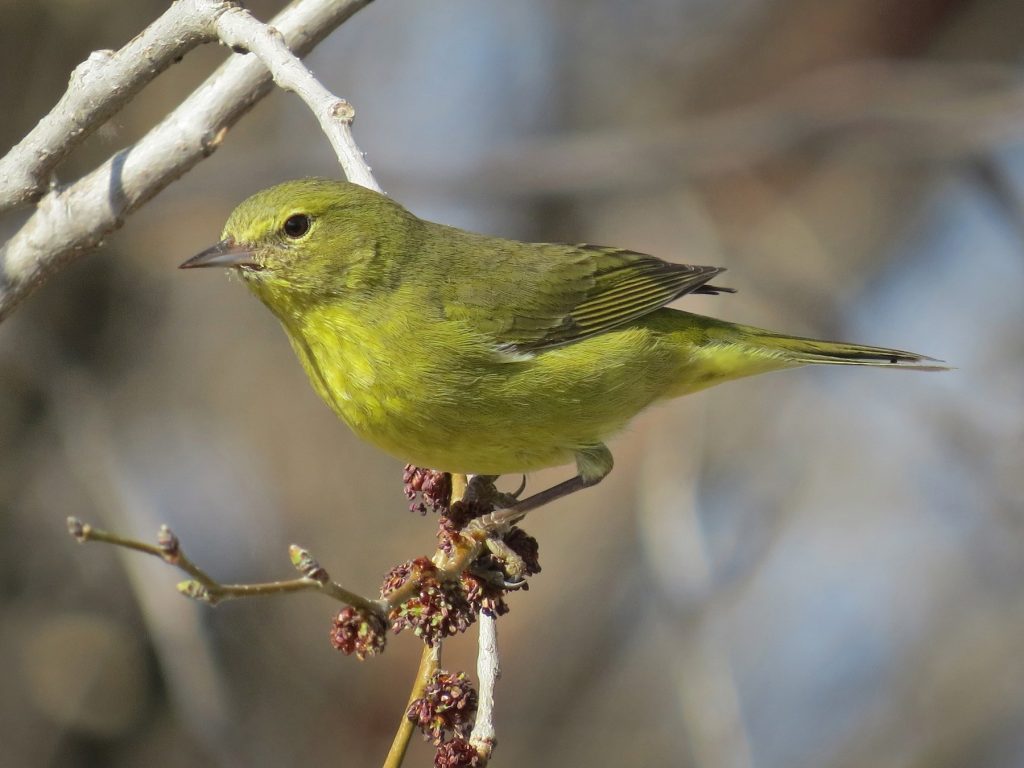
While sightings of Orange-crowned Warblers are not frequent in Nova Scotia, they can be observed during the fall migration, and some individuals choose to remain until winter. Their presence is typically noted between October and December.
Orange-crowned Warblers may lack the vibrant colors of other warbler species, donning a yellow-olive hue with a more pronounced yellow tone on the Pacific Coast. Their orange crown is rarely visible.
Scientific name: Leiothlypis celata
Length: 4.3-5.5 inches (11-14 cm)
Weight: 0.3-0.4 ounces (7-11 g)
Wingspan: 7.5 inches (19 cm)
Breeding occurs in Canada and western US states for Orange-crowned Warblers before embarking on migration to the Pacific, East and Gulf Coasts, and Mexico. While they can be spotted during migration across all US states except the northeastern region.
These warblers are commonly found in shrubs, low vegetation, and open woodlands, where they forage diligently for spiders, insects like caterpillars and flies, as well as fruit, berries, and seeds. They are also known
to visit backyard feeders.
Listen to the sweet song of the Orange-crowned Warbler:
Credit: XC671865, Paul Marvin. Accessible at www.xeno-canto.org/671865.
Nests of Orange-crowned Warblers are situated near or on the ground and crafted from dead leaves, twigs, stems, and lined with soft grass and animal hair. A typical clutch consists of up to six eggs.
To attract Orange-crowned Warblers to your yard, offer suet and peanut butter or provide hummingbird feeders filled with sugar water nectar.
Fun Fact: Orange-crowned Warblers can be seen sipping from sapwells created by sapsuckers and woodpeckers.
17. Eastern Meadowlark

Eastern Meadowlarks, although near-threatened in Nova Scotia, have been occasionally observed throughout the year, albeit infrequently.
Medium-sized and captivating, Eastern Meadowlarks showcase bright yellow underparts, while their upperparts display a pale brown hue adorned with distinctive black markings. A striking black band spans across their chest.
Scientific name: Sturnella magna
Length: 7.5-10.2 inches (19-26 cm)
Weight: 3.2-5.3 ounces (90-150 g)
Wingspan: 13.8-15.8 inches (35-40 cm)
Eastern Meadowlarks can be found year-round across eastern US states, with breeding also occurring in the Northeast and Canada before embarking on their southern migration.
Spring unveils the melodious songs and enchanting displays of Eastern Meadowlarks, marking the arrival of the season. Sadly, their near-threatened status is cause for concern.
You can spot Eastern Meadowlarks on the ground, frequenting grasslands and prairies, where they diligently search for insects. During winter, they gather in large flocks in fields, feeding on seeds.
Listen to the flute-like whistles of Eastern Meadowlarks:
Credit: XC645468, Manuel Grosselet. Accessible at www.xeno-canto.org/645468.
Nests of Eastern Meadowlarks, crafted with finesse, are situated on the ground and feature intricate constructions that include tunnels and roofs woven from grasses.
Fun Fact: Eastern Meadowlarks are capable of singing more than 100 different songs.